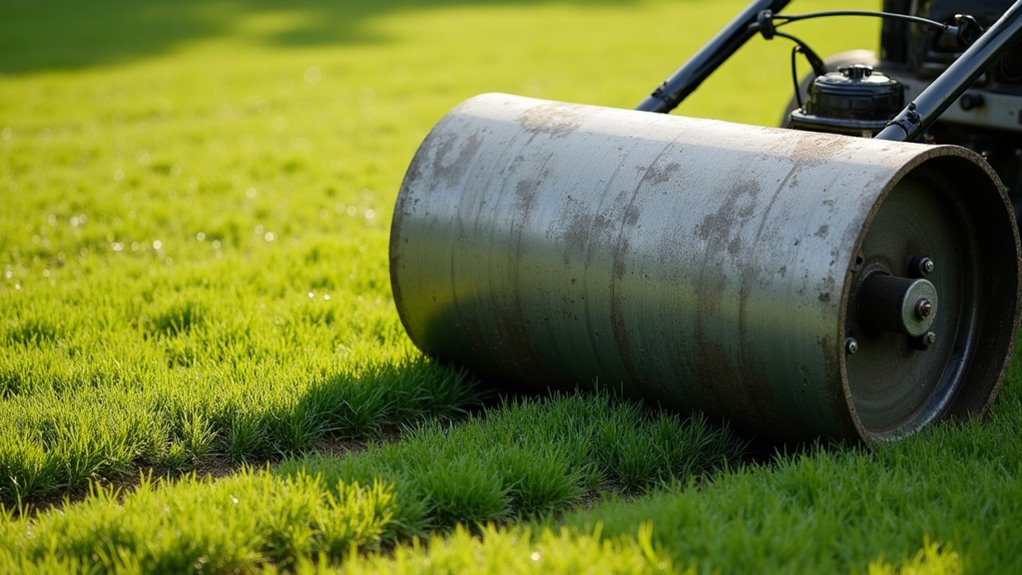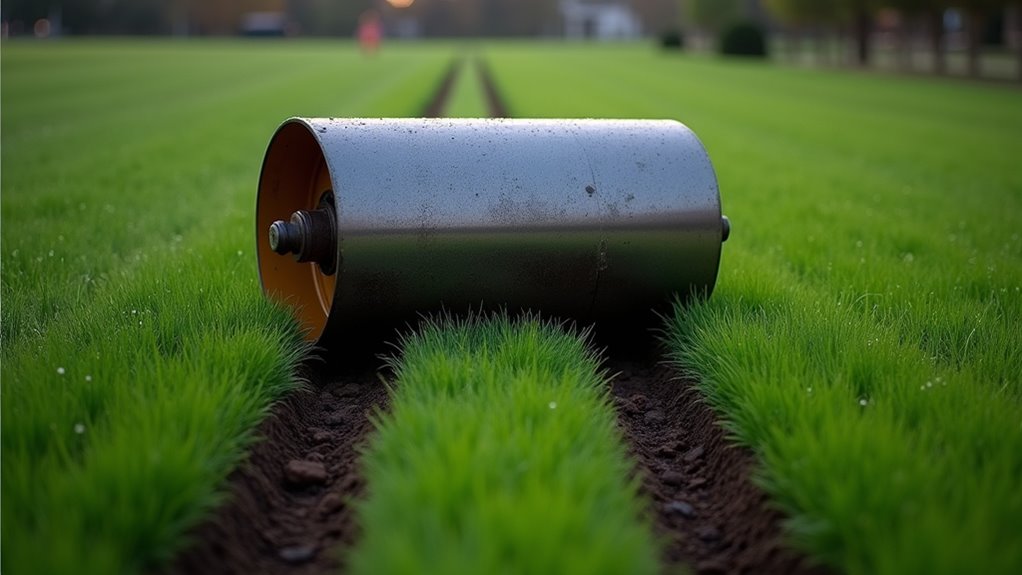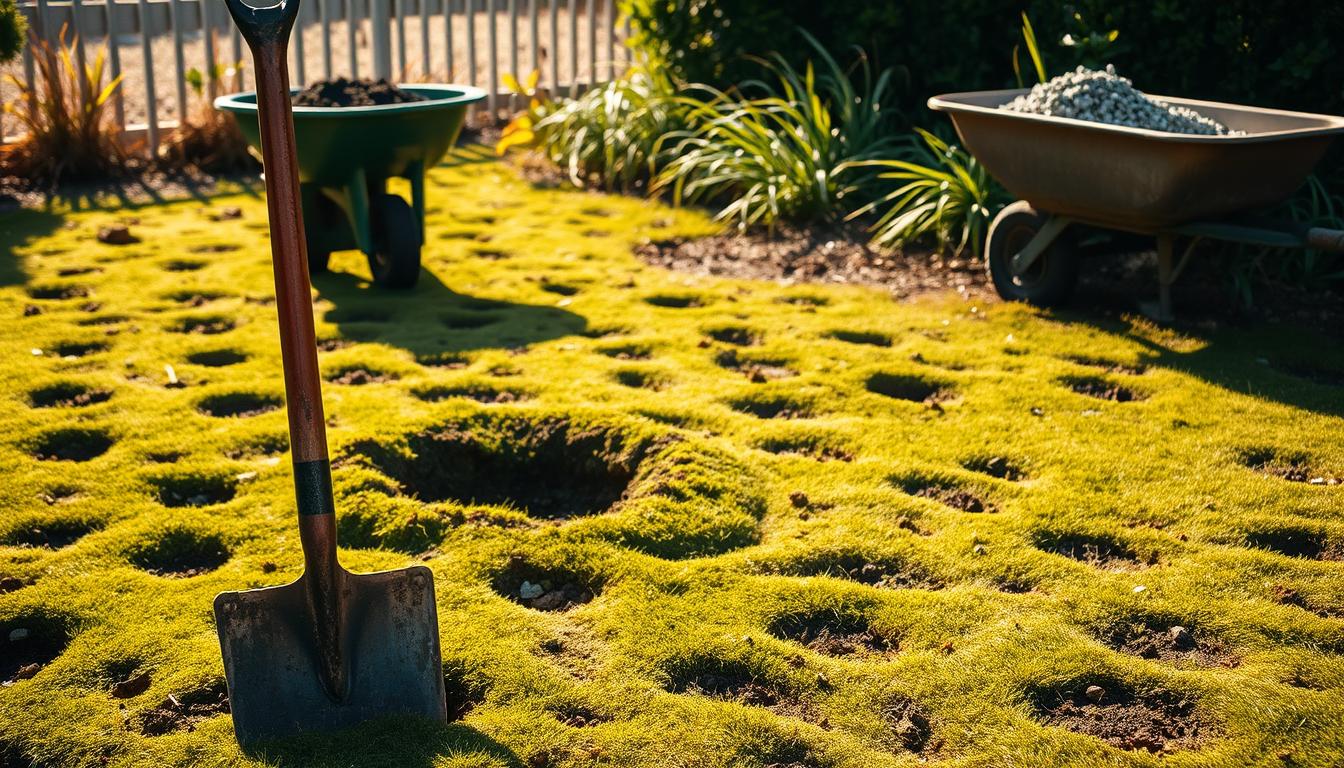A lawn water roller helps you achieve ideal soil-to-seed contact and create a professionally leveled surface. You’ll want to use it during early spring or late fall when soil moisture levels are perfect, maintaining a steady 2-3 mph pace while overlapping your lines. Different roller types suit specific needs: steel for hillsides, polyurethane for precision, and plastic for basic maintenance. Proper timing and technique, combined with regular maintenance, will release your roller’s full lawn-enhancing potential.
Understanding Water Rollers and Their Purpose

When maintaining a healthy lawn, a water roller serves as an essential mechanical tool designed to achieve ideal soil compression and surface leveling. You’ll find this cylindrical device particularly effective when using it to improve soil-to-seed contact, which directly boosts, augments, or amplifies grass growth and establishment.
Types of Lawn Rollers for Different Needs
A thorough understanding of lawn roller types enables you to select the ideal equipment for your specific terrain and soil conditions. When considering lawn maintenance and soil compaction needs, you’ll find that different materials offer distinct advantages for achieving an even lawn surface.
- Steel rollers provide exceptional performance on hillsides and challenging terrain, delivering superior durability and effective soil compaction through their heavier weight
- Polyurethane rollers excel in maneuverability, making them ideal for intricate lawn rolling patterns and areas requiring precise control
- Plastic rollers serve well for basic lawn maintenance tasks, while concrete rollers deliver maximum compaction for intensive projects
Your choice should align with your lawn’s specific requirements, considering factors such as terrain type, soil composition, and the frequency of lawn rolling activities. The right roller guarantees efficient operation and ideal results for your lawn care goals.
Best Times to Use a Water Roller

Timing your lawn rolling activities strategically can optimize effectiveness while preventing soil damage. You’ll achieve the best results by using your water roller during early spring and late fall when soil moisture levels are ideal. These seasons provide the perfect balance, as the ground isn’t overly saturated or too dry.
The rolling process is particularly essential after installing new sod or overseeding your lawn, as it guarantees proper contact between seeds and soil for successful germination. Late fall rolling helps level your turf before winter dormancy. However, you’ll want to avoid rolling during summer’s peak when soil is hardened, as this can lead to harmful compaction. Furthermore, don’t roll immediately following heavy rain or aeration procedures, as excessively soft soil can sustain structural damage under the roller’s weight.
Proper Rolling Techniques for Maximum Results
Several key techniques guarantee preferred lawn rolling results when using a water-filled roller. To safeguard even soil compaction, maintain a consistent speed of 2-3 mph while operating the roller in straight, overlapping lines. Proper rolling techniques require you to cover 30% of the previous pass with each new strip, creating uniform pressure across your lawn’s surface.
- Roll in alternating directions (north-south, then east-west) to prevent creating ridges and ensure grass roots establish evenly
- Keep the roller filled to 1/3 capacity for gentle leveling, or 2/3 for firmer soil conditions when addressing severe bumps
- Maintain steady pressure while using a lawn roller, avoiding stops or turns that could create depressions or damage emerging grass
Monitor soil moisture levels – aim for slightly damp but not saturated ground for optimal outcomes.
Soil Conditions and Moisture Requirements

To achieve ideal lawn rolling results, you’ll need soil moisture levels between 40-60%, which allows the ground to be pliable without becoming waterlogged or causing compaction issues in McKinney’s clay-based soils. You can test ground saturation by walking on the lawn – if water seeps up around your footsteps, it’s too wet, but if the soil feels firm yet slightly gives under pressure, you’ve hit the perfect spot. Your seasonal timing matters greatly, as spring and fall typically provide natural moisture conditions that are perfect for rolling, while summer heat can quickly dry out soil and winter frost can create problematic ground conditions.
Ideal Soil Moisture Levels
Maintaining precise soil moisture levels stands as a critical factor when using a lawn water roller effectively. You’ll need to guarantee your ground is damp but not waterlogged to achieve ideal results. The soil should be malleable enough to respond to the roller’s pressure while maintaining its structural integrity for proper leveling.
- Test the ground by walking on it – your footprints should be visible but not sink deeply into the soil
- Water your lawn lightly before rolling, or plan to roll after a mild rain when moisture levels are balanced
- Avoid rolling when the ground is overly wet, as this can cause severe compaction and drainage issues
Testing Ground Saturation
Before initiating the lawn rolling process, you’ll need to conduct specific ground saturation tests to verify suitable soil conditions. Using a moisture meter, you can accurately measure soil water content to determine if your lawn is ready for rolling. Insert the meter probe at distinct points across your yard to confirm consistent readings.
Your soil moisture should register in the damp range without being waterlogged. If you don’t have a moisture meter, press your thumb into the ground saturation. The soil should feel moist but not leave water marks on your skin. Watch for warning signs of improper conditions: crumbly texture indicates soil that’s too dry, while muddy or sticky consistency suggests oversaturation. Testing multiple areas helps identify spots that may need supplementary drainage or moisture adjustment before rolling.
Seasonal Moisture Considerations
While seasonal changes directly affect soil moisture levels throughout the year, early spring typically provides ideal conditions for lawn rolling. You’ll find the soil more pliable and resilient during this period, allowing you to compact the soil effectively without risking damage to the grass’s root system. When the ground retains satisfactory moisture content, you’ll achieve a lawn that’s both resilient and visually appealing.
- Monitor soil dampness after light rainfall – it should feel slightly moist but not leave water marks on your shoes
- Test uneven areas before rolling by pressing your thumb into the soil – if water seeps up, wait for drier conditions
- Check water flow patterns across your lawn to identify potential drainage issues that could affect soil compaction
Maintain consistent moisture levels through light watering post-rolling to guarantee proper soil settlement and root establishment.
Common Mistakes to Avoid When Rolling
To achieve ideal results with a lawn roller, you’ll need to avoid several critical mistakes that can damage your turf and soil structure. Primarily, don’t overuse your roller, as this leads to excessive soil compaction that restricts essential water and air movement through the soil profile. You’ll also need to carefully time your rolling activities – working with dry soil can cause cracking, while wet soil becomes over-compacted.
Don’t rely on rolling alone to fix an uneven lawn, as this approach won’t address underlying issues. Instead, combine rolling with proper preparation methods like aeration and topdressing. When selecting your equipment, make sure you’re not using an overly heavy roller for your lawn’s size, as this creates concentrated areas of soil compaction that impair drainage and nutrient uptake.
Maintenance and Storage Tips
Your lawn roller’s longevity depends on proper post-use cleaning, which includes thoroughly removing grass debris and drying the drum to prevent rust formation. During winter months, you’ll need to drain all water from the roller, apply a protective lubricant to metal components, and store it in a covered location away from precipitation and freezing temperatures. You can extend your roller’s service life by conducting monthly inspections of bearings, seals, and structural elements, replacing worn parts promptly to maintain ideal performance.
Proper Cleaning Methods
Regularly maintaining your lawn roller through proper cleaning and storage practices dramatically improves its lifespan and guarantees maximum performance. After each use, thoroughly rinse your lawn roller to prevent debris buildup, reducing the risk of uneven rolling patterns and surface damage. A wire brush cleaning of the edges secures your lawn remains consistently level during future applications.
- Apply a protective coat of lightweight oil or rust-preventative spray to shield metal surfaces from corrosion
- Store the equipment in a covered, dry location to prevent weather-related deterioration
- Inspect bearings and axle components before each use to maintain superior rolling efficiency
These meticulous cleaning methods not only extend your lawn roller’s durability but also guarantee Lawn Care Services achieve professional-grade results with an even lawn surface every time.
Winter Storage Guidelines
When winter approaches, proper storage of your lawn roller becomes critical for preventing structural damage and ensuring ideal performance in the following season. After using lawn rollers to create that level lawn you’ve worked hard to maintain, follow these essential winter storage guidelines.
| Storage Task | Purpose |
|---|---|
| Drain Water | Prevent freezing and cracking |
| Clean Thoroughly | Remove grass and debris |
| Indoor Storage | Protect from elements |
| Apply Protective Coating | Prevent rust formation |
| Avoid Weight Stacking | Maintain structural integrity |
Before storing your roller, you’ll need to completely drain any remaining water to prevent freeze damage. Clean off all grass clippings and dirt, then apply a rust-preventative coating to protect metal surfaces. Store your roller in a dry garage or shed, and don’t stack heavy items on top that could compromise its ability to create an even lawn next season.
Rolling for New Seed and Sod Installation
Proper soil-to-seed contact serves as the foundation for successful lawn establishment, making a lawn roller an essential tool for both seeding and sodding projects. When spreading grass seed, you’ll need a lawn roller to guarantee optimal seed-to-soil contact for maximum germination rates. The best time of year for rolling your lawn is during installation, as this process aids in pressing sod into the soil and eliminates problematic air pockets.
- Compaction from rolling improves moisture retention and nutrient uptake, leading to stronger root development
- Rolling creates a uniform surface level, preventing uneven growth patterns and ensuring consistent grass coverage
- For new installations, rolling helps achieve proper soil contact while maintaining ideal growing conditions for seed germination
This mechanical process enhances seed establishment and sod rooting, dramatically improving your lawn’s chances of successful growth and development.
Seasonal Rolling Strategies
Successful lawn rolling requires strategic timing throughout the year to maximize benefits while minimizing potential turf damage. To guarantee the best results, you’ll want to use a lawn roller during early spring or late fall when soil moisture levels are ideal for gentle compaction. These seasons provide optimum conditions that make rolling most effective while reducing the risk of harming your turf.
Avoid rolling during summer’s hot, dry conditions or when your lawn is water-saturated, as this can create lasting soil compaction issues. Instead, focus on problem areas that need leveling during the prime seasonal windows. An even lawn makes maintenance easier throughout the year, but remember to incorporate rolling as just one component of your complete lawn care routine. Strategic seasonal rolling helps maintain a smooth, healthy surface without overdoing it.
Combining Rolling With Other Lawn Care Practices
To optimize your lawn’s health and appearance, rolling must be strategically coordinated with other essential maintenance practices. You’ll achieve an even, uniform lawn when you synchronize rolling with proper aeration and overseeding. These practices work together to address soil compaction while promoting robust grass growth.
- Combine aeration with rolling to improve soil structure and boost water absorption, guaranteeing your lawns specific needs are met through better nutrient uptake.
- Time your rolling sessions between mowing your lawn to maintain ideal grass height and prevent stress on the turf.
- Integrate rolling with overseeding to ensure proper seed-to-soil contact, helping achieve a healthy lawn by filling in bare spots.
This systematic approach creates a comprehensive maintenance strategy that maximizes the benefits of each lawn care practice while minimizing potential turf damage.
Frequently Asked Questions
Is Lawn Rolling Good for Your Lawn?
Lawn rolling can be both beneficial and harmful to your lawn’s health. While it aids in surface leveling and growth stimulation through better seed-to-soil contact, you’ll need to be cautious about compaction reduction. If you roll your lawn too frequently or when soil’s too wet, you’ll risk damaging root systems. For ideal results, you should prioritize soil aeration and only use rolling sparingly. Consider your lawn’s specific conditions before deciding to roll.
What Can I Put on My Lawn to Make It Healthier?
To improve your lawn’s health, you’ll need a multi-faceted approach. Start with proper aeration techniques in spring or fall to reduce soil compaction. Follow up with balanced fertilizer application based on soil test results, typically using a NPK ratio suitable for your grass type. Implement strategic overseeding to fill bare patches, and maintain consistent irrigation scheduling—about 1-1.5 inches of water weekly. Consider organic soil amendment options like compost to bolster soil structure and nutrient content.
What Month Should You Roll Your Lawn?
You’ll get the best results rolling your lawn in early spring (March-April) or late fall (October-November) when there’s perfect moisture in the soil. These periods provide ideal conditions since the ground isn’t waterlogged or too dry. You should aim for soil that’s slightly damp but not soggy to prevent excessive soil compaction. If you’re looking to level topography, early spring is particularly effective as the grass is beginning its active growth phase.
Should You Roll Your Lawn Before or After Mowing?
You’ll get better results by rolling your lawn after mowing, not before. This timing allows you to address uneven spots without damaging freshly cut grass. Wait 1-2 days post-mowing before rolling to let the grass recover. Consider the ideal lawn rolling frequency (1-2 times per year) and check soil compaction levels, as excessive rolling impacts grass growth negatively. If needed, aerate lawn after rolling to prevent soil from becoming too dense.






